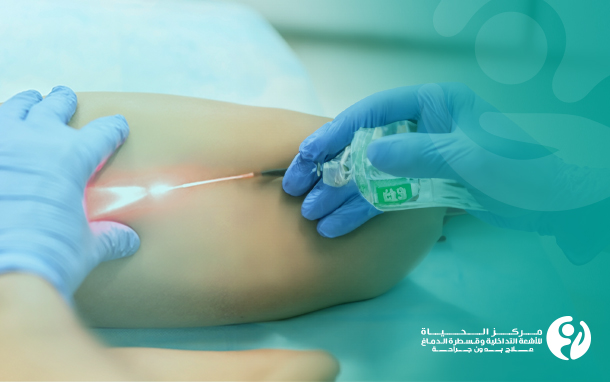Treatment of Thyroid Gland Enlargement with Interventional Radiology
Goiter is a common condition caused by thyroid gland dysfunction. Significant enlargement of the thyroid gland can cause symptoms such as difficulty in breathing and swallowing, affecting the quality of life. In recent years, interventional radiology treatment has become an innovative and reliable option for treating thyroid gland enlargement. Let us explore how interventional radiology treats goiter and its benefits.
Interventional radiology treatment uses precise imaging-guided techniques to guide the catheter accurately into the thyroid gland. The therapy aims to target the nodules and destroy the excess thyroid cells through ablation or embolization of its blood supply; reducing the gland size. The target area for treatment is determined based on a detailed analysis of the thyroid gland using three-dimensional imaging techniques.
Causes of goiter:
The thyroid gland is one of the most important endocrine glands in the human body, playing a crucial role in regulating the body's functions and maintaining hormonal balance. If any disturbance occurs in this gland, it can lead to thyroid gland enlargement. Let's discuss the main causes of thyroid gland enlargement:
1. Iodine deficiency: Iodine deficiency in the diet is one of the most common causes of thyroid gland enlargement. Iodine is an essential nutrient required for the production of thyroid hormones. If adequate iodine is not provided, the thyroid gland will try to compensate by increasing its size.
2. Inflammation: Severe inflammation in the thyroid gland due to chronic diseases can also lead to its enlargement.
3. Thyroid gland tumors: The presence of non-cancerous tumors in the thyroid gland can cause it to enlarge, and although most of these tumors are not malignant, some may be cancerous.
4. Genetic factors: Genetic factors can play a role in thyroid gland enlargement. If a family member has this disorder, the likelihood of developing it may increase.
Symptoms of simple goiter:
1. Neck swelling: An increase in the size of the thyroid gland can cause swelling in the neck area.
2. Difficulty swallowing or speaking: Significant enlargement of the thyroid gland can put pressure on the trachea or esophagus, leading to difficulty swallowing or speaking.
3. Weight changes: Weight changes may be observed. An enlarged thyroid gland can cause weight gain or loss.
4. Fatigue and weakness: Thyroid gland disorder can cause severe fatigue and weakness.
Complications of goiter:
1. Hyperthyroidism: In some cases, thyroid gland enlargement can lead to hyperthyroidism, resulting in elevated thyroid hormone levels and increased metabolic rate.
2. Pressure on surrounding organs: In cases of severe gland enlargement, the thyroid can press on surrounding organs such as the trachea or esophagus, causing respiratory problems or swallowing difficulties.
3. Tumor formation: In some rare cases, non-cancerous growths in the gland can potentially transform into cancerous tumors.
Advantages of treating goiter with interventional radiology:
1. Highly effective: Studies have shown that interventional radiology treatment can be effective in reducing thyroid gland size and improving symptoms associated with enlargement. The gland size can shrink by 50 to 60% after treatment.
2. Non-Surgical treatment: Interventional radiology is a non-surgical alternative to thyroidectomy (surgical removal of the thyroid gland) in cases of gland enlargement. Compared to surgery, interventional radiology treatment is less invasive and requires a shorter recovery time.
3. Ease of implementation: Interventional radiology treatment is a non-invasive and non-complex procedure. It is performed using a specialized device that precisely directs radiation toward the thyroid gland without affecting the surrounding healthy tissues. Interventional radiology treatment of goiter is an innovative and promising treatment option to reduce the enlarged gland size and improve associated symptoms.
4. Preserving the gland: Maintaining the functionality of the thyroid gland, which eliminates the need for lifelong thyroid hormone replacement therapy, which is mandatory after surgical thyroid gland removal.
Consider the following important points before treating goiter with interventional radiology:
1. Case evaluation: Specialist doctors at Al Hayat Center for Interventional Radiology and Neurointervention carefully evaluate the patient's condition before interventional radiology treatment. Additional tests such as thyroid gland examination and blood tests may be requested to accurately determine thyroid gland function and the enlargement degree.
2. Symptoms and side effects: The symptoms associated with thyroid gland enlargement and the potential side effects of the treatment must be considered. Common symptoms may include shortness of breath, swallowing difficulties, and pressure on surrounding nerves. The physician discuss these symptoms and the benefits of interventional radiology treatment.
3. Follow-up and post-treatment care: Al Hayat Center for Interventional Radiology and Neurointervention provides appropriate post-treatment care for patients treated for goiter with interventional radiology. This care includes regular check-ups to evaluate the thyroid gland's response to the treatment and monitor for potential side effects.
What are the regular check-ups after interventional radiology treatment for goiter?
It is extremely important to carefully monitor the patient after treating thyroid gland enlargement with interventional radiology, as this helps achieve the best results and manage any potential side effects. The patient must follow the physician's instructions and stick to regular check-ups to maintain thyroid gland health and ensure the continued effectiveness of the treatment. The frequency of the regular check-ups depends on the patient's condition and the physician recommendations. The physician may establish a follow-up schedule that includes specific dates for tests and follow-up visits, which are carried out through:
1. Thyroid examination: The thyroid examination helps assess the gland's size and any changes. The thyroid gland is examined by palpation and observing any changes in size and texture.
2. Blood tests: Blood tests include analysis of thyroid hormone levels such as thyroxine (T4) and thyroid-stimulating hormone (TSH). These tests can help evaluate thyroid function and the impact of interventional radiology on hormone production.
3. Imaging: A CT scan or MRI may be requested to assess changes in thyroid gland size and monitor the effects of interventional radiology treatment.
4. Symptom monitoring: The patient should report any changes in thyroid-related symptoms after interventional radiology treatment. These symptoms may include excessive fatigue, anxiety, weight gain or loss, and mood changes. These symptoms should be evaluated and discussed with the physician.
Enlarged thyroid gland is a disorder that can lead to serious health problems if not properly managed. If you are experiencing symptoms indicating thyroid enlargement, we recommend visiting the interventional radiology and neurointervention center for non-surgical treatment of thyroid enlargement. Al Hayat Center for Interventional Radiology and Neurointervention is the first center for interventional radiology in Iraq, where you can benefit from the advantages of non-surgical treatment of thyroid enlargement with interventional radiology.

